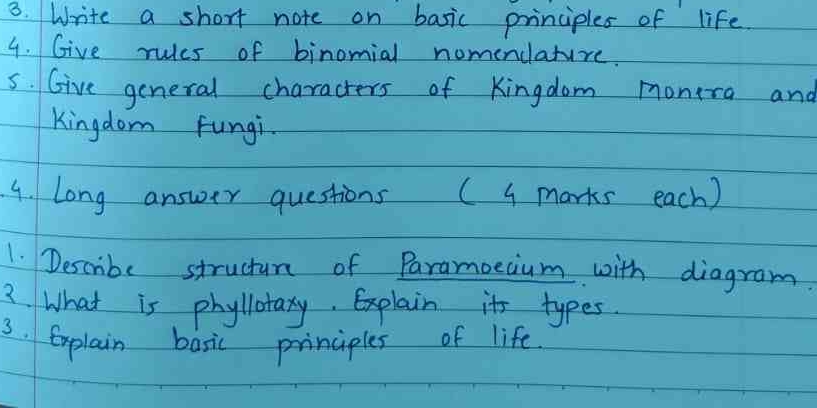Write a short note on basic principles of life. Give rules of binomial nomenclature. Give general characters of Kingdom Monera and Kingdom Fungi. Describe structure of Paramecium w... Write a short note on basic principles of life. Give rules of binomial nomenclature. Give general characters of Kingdom Monera and Kingdom Fungi. Describe structure of Paramecium with diagram. What is phyllotaxy? Explain its types. Explain basic principles of life.

Understand the Problem
The question is asking for short notes on various scientific concepts, including principles of life, binomial nomenclature, characteristics of biological kingdoms, and detailed explanations of specific biological structures and processes, which indicates a focus on biology.
Answer
Principles: homeostasis, metabolism; Binomial: genus/species; Monera: unicellular, prokaryotic; Fungi: eukaryotic, chitin wall; Paramecium: ciliated protozoan; Phyllotaxy: leaf arrangement (alternate, opposite, whorled).
The basic principles of life include homeostasis, organization, metabolism, growth, adaptation, response to stimuli, and reproduction.
Rules of binomial nomenclature involve using two names: genus and species, both italicized, with the genus capitalized.
Kingdom Monera includes unicellular prokaryotic organisms like bacteria. Kingdom Fungi includes eukaryotic organisms with a cell wall made of chitin, such as mushrooms.
Paramecium is a ciliated protozoan with a slipper-shaped body, a macronucleus, and a micronucleus. It uses cilia for movement and feeding.
Phyllotaxy is the arrangement of leaves on a plant stem and includes alternate, opposite, and whorled types.
Answer for screen readers
The basic principles of life include homeostasis, organization, metabolism, growth, adaptation, response to stimuli, and reproduction.
Rules of binomial nomenclature involve using two names: genus and species, both italicized, with the genus capitalized.
Kingdom Monera includes unicellular prokaryotic organisms like bacteria. Kingdom Fungi includes eukaryotic organisms with a cell wall made of chitin, such as mushrooms.
Paramecium is a ciliated protozoan with a slipper-shaped body, a macronucleus, and a micronucleus. It uses cilia for movement and feeding.
Phyllotaxy is the arrangement of leaves on a plant stem and includes alternate, opposite, and whorled types.
More Information
Phyllotaxy is crucial for maximizing light capture and is a key factor in plant morphology studies.
Tips
Avoid mixing up the binomial name order; the genus name always comes first.
Sources
AI-generated content may contain errors. Please verify critical information